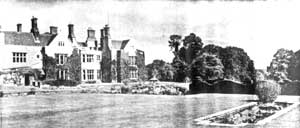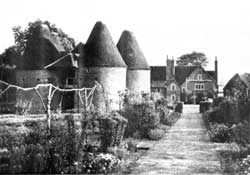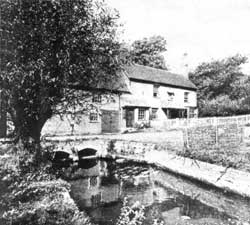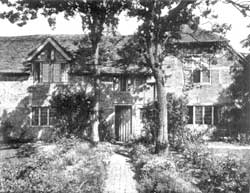
|
This particular article, by Christopher
Hussey, was written for Country Life magazine and published on the 19th December 1941. |
||||||
| AN ENGLISH VILLAGE FROYLE, HAMPSHIRE - 1 |
||||||
| On the course of the Pilgrim’s Way between Farnham and Alton, Froyle is a typical community of yeoman farmers who prospered with wheat and hops in the eighteenth century |
||||||
On the course
of the Pilgrim’s Way between
Farnham and Alton, Froyle is a typical community of yeoman farmers
who prospered with wheat and hops in the eighteenth century. North-East
Hampshire is one of those pleasant regions that events and people
have generally passed by, for it contains little to divert them
from the highways which conveniently define it; the London - Winchester
road via Farnham (the “Pilgrims’ Way”); the
Farnham - Odiham - Basingstoke road ; and the Roman road from Winchester
to Silchester and Basingstoke. The parish of Froyle, off the first
of these, between Farnham and Alton, is typical of this triangle
of chalk plateau: open arable upland, lying between the 400ft
and 600ft contours, in places rising to over 700ft., with hanging
beechwoods and wide views and remote little villages. A peaceful,
uneventful countryside even now, when its gentle downs are again
great sweeps of light brown plough, golden in summer streaked with
the dark green of the beech-hangars against far blue distances.
The village’s geological position, strung out along the Chalk - Greensand divide, is well seen looking south from one of the downland spurs which make the hinterland of Froyle a succession of broad arable combes. The line of the divide is marked by the belt of trees in which Upper Froyle shelters. Beyond, and across the Wey, rises the Greensand ridge, ancient woodland of which the royal forest of Alice Holt is a large remnant. The River Wey and the Farnham - Winchester road run parallel to and about half a mile south of Upper Froyle, which lies on a loop - road from the present highway. The Pilgrim’s Way from Winchester to Canterbury followed the left bank of the river between Alton and Farnham. The existing main road gives the impression of being of later date, or at least of following the lower track of the Way. Like a caravan route, the prehistoric trackways frequently consisted of a wide belt of thoroughfare, and there is evidence elsewhere that the Pilgrims’ Way had winter and summer courses. Along most of its route it follows the divide of the Chalk and Greensand, the winter line being just on the Chalk, the summer route taking short cuts and a lower line across stretches of Greensand, which in winter tended to be of bad going.
This characteristic also holds good of Lower Froyle, an offshoot of the village, not, as in the case of its neighbours, on the pilgrims summer route, but along a spur-road northwards across the downs towards Odiham. Spread along a wide combe, a mile and a half north of the church, the lower village comprises many of the most picturesque and ancient tenements in the parish. Like so many Hampshire manors, Froli (as it was spelt in Domesday) was Winchester Church land. Edward the Confessor had given it to the nuns of St. Mary’s Abbey, a connection perpetuated by the dedication of the church to the Assumption of the Blessed Virgin; and the sub-manor of Coldrey, between Froyle and Bentley, belonged to the Bishop of Winchester, whose principal seat was, of course, Farnham Castle. At the dissolution of the monasteries the manor of Froyle was acquired by William Jephson, whose descendants till 1652 owned the Manor Place which stands beside the church. Held for a few years by John and Robert Fiennes, they sold it in 1666 to Samuel Gauden of Lincoln’s Inn Fields. From his descendants the Drapers, extinct in 1765, it passed to the Nicolas family, who parted with the property piecemeal between 1765-82 to Sir Thomas Miller, fifth baronet, the ancestor of the late Sir Hubert Miller, to whom Froyle owes so much of its charm today.  Froyle
Place is said to have been built in 1588, and it is, in the main,
a gabled
U-shaped Elizabethan manor house of the local clunch or hard chalk.
A cellar at the north-west retains two fine Tudor doorways, and
an adjacent quoin bears a consecration cross. Towards the end of
the eighteenth century, probably when bought by the Millers, sash
windows were inserted, and the principal rooms modernised in the
Adam taste; in about 1865 and later, further and less attractive
alterations were made, including that of the centre between the
wings on the south-east front. More recently the gardens were laid
out with uncommon charm, and attractive feature being a curving
double border sunk between a convex terrace and a clipped yew hedge.
The house contains Miller family portraits, several by Reynolds,
Cotes and other good painters, going back to the first baronet,
who was buried in Chichester Cathedral in 1705; also two outstanding
landscapes by Smith of Chichester, and a magnificent Gaspar Poussin
landscape. The present tenant is the Hon. Mrs. Milo Talbot. Froyle
Place is said to have been built in 1588, and it is, in the main,
a gabled
U-shaped Elizabethan manor house of the local clunch or hard chalk.
A cellar at the north-west retains two fine Tudor doorways, and
an adjacent quoin bears a consecration cross. Towards the end of
the eighteenth century, probably when bought by the Millers, sash
windows were inserted, and the principal rooms modernised in the
Adam taste; in about 1865 and later, further and less attractive
alterations were made, including that of the centre between the
wings on the south-east front. More recently the gardens were laid
out with uncommon charm, and attractive feature being a curving
double border sunk between a convex terrace and a clipped yew hedge.
The house contains Miller family portraits, several by Reynolds,
Cotes and other good painters, going back to the first baronet,
who was buried in Chichester Cathedral in 1705; also two outstanding
landscapes by Smith of Chichester, and a magnificent Gaspar Poussin
landscape. The present tenant is the Hon. Mrs. Milo Talbot.Great events, like the main road, have by-passed Froyle, so that its history, lacking a Gilbert White, is that of the yeoman families whose names are still borne by many of their houses. Those of Froyle have left scanty records, but the village is fortunate in having a schoolmaster, Mr. T. Knight, who has searched them out. Nor are parochial records of local interest only; they are the microcosm of national history, particles in a greater design. The tenement with the longest history in the village is that known since the thirteenth century as Hussey’s in Lower Froyle. The “manor” of Hussey’s is mentioned in 1262-63 as then acquired by Walter Hussey of his brother William ; in 1336 and 1382 it was held by Nicolas Hussey. John Mott of Froyle, bequeathing money for candles to burn in the Easter Sepulchre in 1377, also deposed that Nicolas owed him £40. In 1414 the latter sold the property, which, for a time, became merged with the adjoining Coldrey Manor, but by 1639 had been acquired by the Jephsons of Froyle Place. They would seem to have leased it at about the same date to henry Burningham, first recorded member of a family that ultimately attained squiredom in Froyle. The Husseys of Froyle were possibly connected with the South Harting family flourishing in Henry III’s time. Parts of their house here may be incorporated in the existing building, timber framed with brick filling, of sixteenth-century date, with a rosy brick Georgian front probably added in 1764. By that date John Baldwin Burningham had probably bought the farm from the Froyle Place estate, the Georgian facade and the unusual group of four oast houses behind the house symbolising the prosperity of wheat and hops at that time. In 1820 Thomas Burningham moved to the more aristocratic air of Upper Froyle, where he reconstructed an earlier building in the classic taste and called it Froyle House, his descendants residing there until about 1895. There are at least eight Henry Burninghams buried in Froyle, the last in 1905. Mr. Knight has worked out a sinister discovery about them : in each case when there was a brother named John or Thomas the eldest son died young if his name was Henry. Hussey’s has recently been restored by Lieutenant-Colonel Broke Grenville. Froyle House, now the home of Captain Sir Hugh Smiley, Bt., is beyond Froyle Place, and, from the evidence of its cellars and some of its walls, was a considerable building in the seventeenth or early eighteenth century. It has not been possible to identify its earlier ownership with certainty, but it may be the property known as Catlees, after an occupier of about 1400, which belonged to the de Windsor family. In 1367 Richard de Windsor died seized of a virgate held of the Abbess of St. Mary’s. Windsors were still here in 1550. Another important property in the village was a sub-manor, held of the chief manor so early as 1363, by Sir John Brocas, a Buckinghamshire family owning estates round Alton till early Tudor times. Brocas Farm lies between Hussey’s and Coldrey in Lower Froyle.
Silvester’s Farm in Lower Froyle is a yeoman’s beautiful little house, the first in the village to be re-built following the development of arable farming in the district. It took its existing form in 1674, according to a date let into its back elevation. This date presumably refers to the time when the wing was added at right angles to a timber-framed early Tudor house, then, or subsequently, hung with weather-tiling on its north and west sides and at the back faced in stone. This use of stone - from a quarry beside the main road - and the whole character of the house, belong rather to the country across the Wey, with its geological affinities to Sussex, than to Froyle and North Hampshire : implying that the latter’s tradition of brick building was not yet established. The 1674 wing has moulded brick window jambs and lintels, with stone mullions on the south and original wooden casements on the north. A Sylvester appears in the registers in 1670, and others of the name up till 1760 ; in 1800 Silvester’s was one of Sir Thomas Miller’s farms. It is now farmed by Mr. Kenneth Goschen. There was a church in Froyle at Domesday, no doubt on the site of the existing one, beside the old Way, the chancel of which dates from about 1300. It has a fine Decorated east window, the tracery lights of which contain a notable display of contemporary heraldic glass, referring in particular to Edward I, his second Queen Margaret of France, Edward of Carnarvon and his connections by marriage - Humphry de Bohun and John de Warenne, Earl of Sussex. Its date must be between 1299 and 1307. The West Tower was built in 1722, of Crondall bricks, recalling in its design the Cromwellian brick tower of Crondall Church, Henry Burningham and John Baldwin being churchwardens. The nave, an oblong hall with a west gallery and cusped “Gothic” windows, is also brick and a renovation of 1812. The builders then were George Parfect of Headley, John Dyer of Alton, and George Beagley of Bentley. It cost £1,297 12s 6d., and was completed between February and September, a remarkable achievement. It was then recorded that the cost of restoring the old nave would cost nearly as much as building a new one. It is quite appropriate that a village, containing so much good eighteenth-century brick building, should have a church largely of that age and material too, and that the names of some of the builders should be preserved. |
||||||
|


